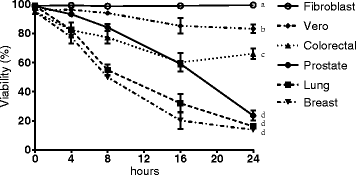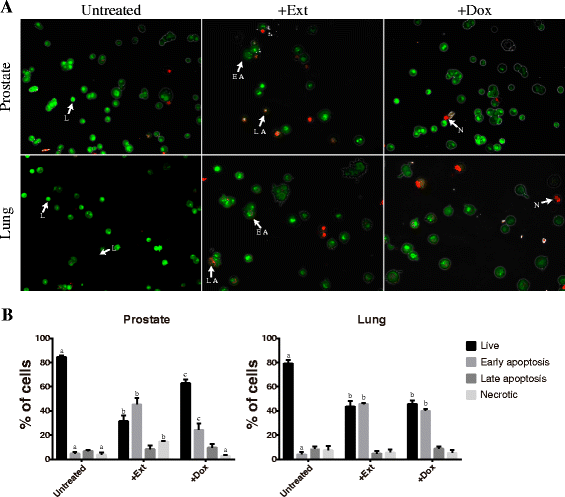Anticancer potential of Thevetia peruviana fruit methanolic extract
- PMID: 28464893
- PMCID: PMC5414213
- DOI: 10.1186/s12906-017-1727-y
Anticancer potential of Thevetia peruviana fruit methanolic extract
Abstract
Background: Thevetia peruviana (Pers.) K. Schum or Cascabela peruviana (L.) Lippold (commonly known as ayoyote, codo de fraile, lucky nut, or yellow oleander), native to Mexico and Central America, is a medicinal plant used traditionally to cure diseases like ulcers, scabies, hemorrhoids and dissolve tumors. The purpose of this study was to evaluate the cytotoxic, antiproliferative and apoptotic activity of methanolic extract of T. peruviana fruits on human cancer cell lines.
Methods: The cytotoxic activity of T. peruviana methanolic extract was carried out on human breast, colorectal, prostate and lung cancer cell lines and non-tumorigenic control cells (fibroblast and Vero), using the MTT assay. For proliferation and motility, clonogenic and wound-healing assays were performed. Morphological alterations were monitored by trypan blue exclusion, as well as DNA fragmentation and AO/EB double staining was performed to evaluate apoptosis. The extract was separated using flash chromatography, and the resulting fractions were evaluated on colorectal cancer cells for their cytotoxic activity. The active fractions were further analyzed through mass spectrometry.
Results: The T. peruviana methanolic extract exhibited cytotoxic activity on four human cancer cell lines: prostate, breast, colorectal and lung, with values of IC50 1.91 ± 0.76, 5.78 ± 2.12, 6.30 ± 4.45 and 12.04 ± 3.43 μg/mL, respectively. The extract caused a significant reduction of cell motility and colony formation on all evaluated cancer cell lines. In addition, morphological examination displayed cell size reduction, membrane blebbing and detachment of cells, compared to non-treated cancer cell lines. The T. peruviana extract induced apoptotic cell death, which was confirmed by DNA fragmentation and AO/EB double staining. Fractions 4 and 5 showed the most effective cytotoxic activity and their MS analysis revealed the presence of the secondary metabolites: thevetiaflavone and cardiac glycosides.
Conclusion: T. peruviana extract has potential as natural anti-cancer product with critical effects in the proliferation, motility, and adhesion of human breast and colorectal cancer cells, and apoptosis induction in human prostate and lung cancer cell lines, with minimal effects on non-tumorigenic cell lines.
Keywords: Anti-proliferative activity; Apoptosis; Cardiac glycosides; Cytotoxic activity; Flavonoid; Human cancer cells; Motility.
Figures






Similar articles
-
Cytotoxic activity of extracts and crude saponins from Zanthoxylum armatum DC. against human breast (MCF-7, MDA-MB-468) and colorectal (Caco-2) cancer cell lines.BMC Complement Altern Med. 2017 Jul 17;17(1):368. doi: 10.1186/s12906-017-1882-1. BMC Complement Altern Med. 2017. PMID: 28716103 Free PMC article.
-
Cardiac Glycosides from the Seeds of Thevetia peruviana.J Nat Prod. 2016 Jan 22;79(1):38-50. doi: 10.1021/acs.jnatprod.5b00611. Epub 2015 Dec 29. J Nat Prod. 2016. PMID: 26714048
-
Cardiac glycosides with cytotoxic activity from the seeds of Thevetia peruviana.Fitoterapia. 2024 Sep;177:106126. doi: 10.1016/j.fitote.2024.106126. Epub 2024 Jul 15. Fitoterapia. 2024. PMID: 39019237
-
Yellow Oleander Seed, or "Codo de Fraile" (Thevetia spp.): A Review of Its Potential Toxicity as a Purported Weight-Loss Supplement.J Diet Suppl. 2018 May 4;15(3):352-364. doi: 10.1080/19390211.2017.1353565. Epub 2017 Sep 28. J Diet Suppl. 2018. PMID: 28956681 Review.
-
Cancer chemoprevention by pomegranate: laboratory and clinical evidence.Nutr Cancer. 2009;61(6):811-5. doi: 10.1080/01635580903285064. Nutr Cancer. 2009. PMID: 20155621 Free PMC article. Review.
Cited by
-
Co-Treatment of Caco-2 Cells with Doxorubicin and Gold Nanoparticles Produced from Cyclopia intermedia Extracts or Mangiferin Enhances Drug Effects.Nanomaterials (Basel). 2022 Nov 7;12(21):3918. doi: 10.3390/nano12213918. Nanomaterials (Basel). 2022. PMID: 36364694 Free PMC article.
-
Mauritian Endemic Medicinal Plant Extracts Induce G2/M Phase Cell Cycle Arrest and Growth Inhibition of Oesophageal Squamous Cell Carcinoma in Vitro.Acta Naturae. 2019 Jan-Mar;11(1):81-90. Acta Naturae. 2019. PMID: 31024752 Free PMC article.
-
Phytochemicals in Prostate Cancer: From Bioactive Molecules to Upcoming Therapeutic Agents.Nutrients. 2019 Jun 29;11(7):1483. doi: 10.3390/nu11071483. Nutrients. 2019. PMID: 31261861 Free PMC article. Review.
-
How Should the Worldwide Knowledge of Traditional Cancer Healing Be Integrated with Herbs and Mushrooms into Modern Molecular Pharmacology?Pharmaceuticals (Basel). 2022 Jul 14;15(7):868. doi: 10.3390/ph15070868. Pharmaceuticals (Basel). 2022. PMID: 35890166 Free PMC article. Review.
-
Identification of novel cyclin-dependent kinase 4/6 inhibitors from marine natural products.PLoS One. 2025 Jan 15;20(1):e0313830. doi: 10.1371/journal.pone.0313830. eCollection 2025. PLoS One. 2025. PMID: 39813224 Free PMC article.
References
-
- World wide cancer statistics. Cancer Research UK. http://www.cancerresearchuk.org/health-professional/cancer-statistics/wo.... Accessed 24 May 2017.
-
- Zia-Ul-Haq M, Riaz M, Saad B. Anthocyanins and Human Health: Biomolecular and therapeutic aspects, 1 ed. Switzerland: Springer International Publishing; 2016.
MeSH terms
Substances
LinkOut - more resources
Full Text Sources
Other Literature Sources
Medical

